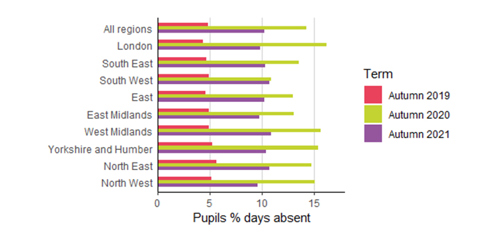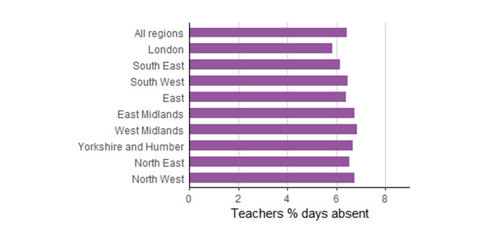Scale of Omicron teacher absence in UK is worse than previous Covid waves
Friday 28 January 2022
 This article was first published in Teaching Times on Thursday 27 January 2022.
This article was first published in Teaching Times on Thursday 27 January 2022.
As the spring term continues amidst high rates of the Omicron Covid-19 variant, pupil and teacher absence rates have been the subject of much concern for many schools.
In a poll of senior leaders, 27 per cent reported that more than 10 per cent of teaching staff were absent due to Covid-related reasons on the first day of term. Responding to such concerns, the Education Secretary said he has “contingency plans for 10, 15, 20, 25 per cent [teacher] absenteeism” and has declared his support for a reduction of the Covid isolation period to five days.
Pupil and teacher absence rates have once again provoked discussions over the possibility of school closures, as well as the fairness of upcoming exams. However, it seems Ofqual is likely to go ahead with GCSE exams in the summer. We have analysed the regional pupil and teacher absence rates using recently updated government data for the autumn term [1].
Below we can see pupil absence rates at a regional level plotted for the autumn terms in 2019 (pre-Covid), 2020 and 2021. This includes absences due to partial school closures.

So far this academic year Covid has had less of an impact on pupil absences than at the same point last year, going from 14.3 per cent absence overall in 2020 to 10.2 per cent in 2021. The regional disparity in absence rates also appears to be reduced in 2021, with a difference of 1.3 per cent between the highest and lowest regions, compared to 5.3 per cent in 2020 and 1.3 per cent in 2019.
We can also look at regional teacher absence data for the autumn term of 2021.

Although teacher absence rate data was not collected pre-Covid, the average number of sick days taken in 2018/19 was 4.1 across all terms and teachers work a maximum of 195 days a year, implying a minimum absence rate of 2.1 per cent.
The overall rate of 6.4 per cent for all regions in autumn 2021 is substantially higher and continues to rise: it was 9.0 per cent on January 20th. In the last school week of autumn 2020, just before schools closed in January, the teacher absence rate was 8.2 per cent [2]. This means the winter months have seen teacher absence rates exceed those which saw schools partially close last time around.
However, regional variation in teacher absences were moderate in the autumn term, with a range of 1.0 per cent between the regions with the highest and lowest rates.
While the West Midlands have seen some of the highest pupil and teacher absence rates in the autumn term, this story is likely to keep changing: Covid-19 rates are highest in the North East as of January 15th.
While pupil absence rates are down compared to the same point last year, teacher absences remain high. This might be expected given that teachers appear to have an elevated vulnerability to contracting Covid compared to other professional roles.
Teacher absence data are factors which help inform decisions around whether schools remain open. While the Government has repeatedly stated that it wants to avoid national school closures, individual school closures remain a real possibility.
Continual monitoring of regional absence variation is a vital tool in attempts to ensure recovery efforts are targeted in the correct areas. In addition to considerations around closures, key decision makers are no doubt also considering the data’s implications on summer exams.
References
[1] Differences in the way attendance statistics are calculated during Covid are likely to reduce attendance figures relative to pre-Covid data. See government website for further methodology details.
[2] Autumn 2020 teacher absence data is available overall but not at a regional level, which is why 2020 data is not plotted on the graph, but it was possible to obtain the figure of 8.2 per cent.
